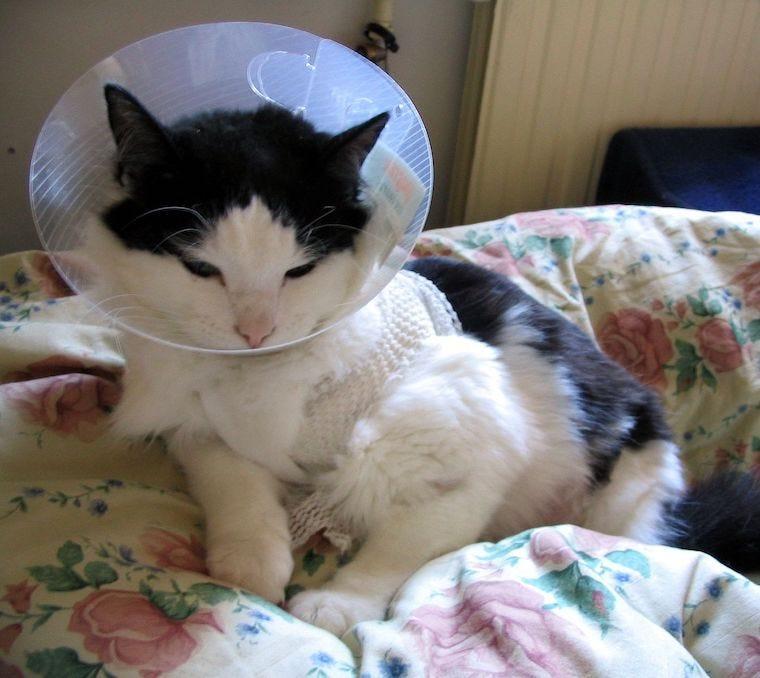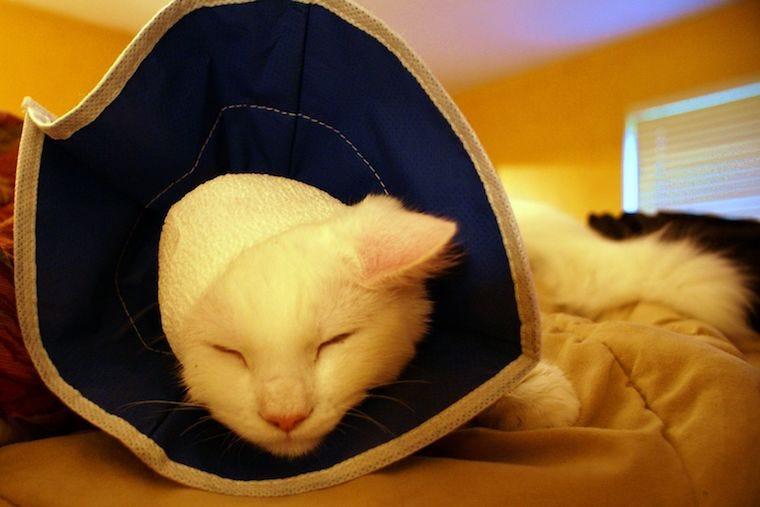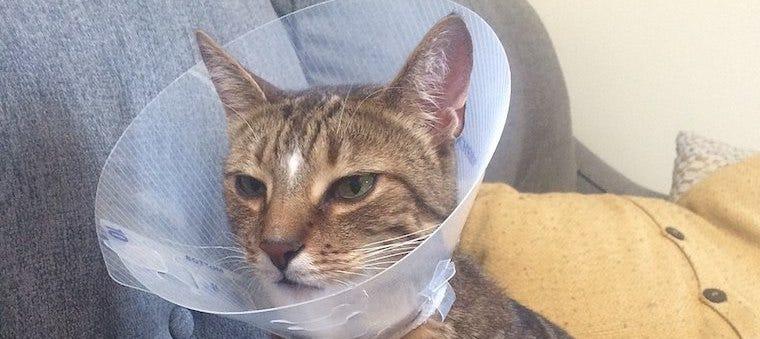Ah, the cone of shame. Following surgery, your cat may suffer the indignity of donning a cat e-collar. So, how do you keep your kitty as comfortable as possible while making sure that his cat cone collar stays on? Learn how to keep e-collars for cats in place, along with other post-surgery tips.
What is a cat e-collar?

A cat e-collar, short for Elizabethan cat collar, is named after the ruffs worn in Elizabethan-era England. Also known as a cat cone collar, this device is sometimes worn by cats post-surgery to allow wounds to heal without interference. Without an e-collar, your cat may be tempted to lick or chew on his sutures during the healing process.
Traditional e-collars for cats look like a plastic hood or cone fastened around the neck. Today, there are more comfortable alternatives to the “cone of shame,” such as a soft or inflatable cat e-collar.
E-collars for cats: 5 tips

So, how can you keep e-collars for cats in place after surgery?
Desensitize your cat before surgery
If possible, expose your cat to an e-collar for the few weeks leading up to his or her surgery. You can purchase a cat e-collar online or potentially from your vet. Once you have the collar in hand, allow your cat to check it out before putting it on him. Reward him with a treat or favorite toy for “interacting” with the cone. This will create a positive association between the cone and the cat.
After a few days of rewarding your cat, it’s time to practice putting the e-collar on your cat. Once the collar is on, Preventative Vet recommends that you feed your cat a small amount of wet food via a spoon or tongue depressor to further reward him for wearing the collar. Leave the collar on for a short amount of time. If at any time your cat begins pawing at the collar and trying to get it off, remove the collar and try again the next day.
Gradually increase the amount of time your cat wears the e-collar. Encourage him to walk around wearing it by holding out treats or dragging a cat wand toy.
Monitor your cat during basic activities
You may find that it’s difficult for your cat to eat, drink, or use the litter box while wearing an e-collar. Be sure to observe your cat’s habits the first day he is wearing a collar so that you can accommodate him as necessary. This may include raising food and water dishes off the floor, providing plates or saucers in place of bowls, hand-feeding your cat, or even trimming the edges of the cone. If your cat uses a covered litter box, you may need to remove the lid so that he can comfortably enter and move around inside while wearing the e-collar. (Note: If your cat can’t fit inside the Litter-Robot, you’ll need to provide another open litter box temporarily.)
Restrict your cat’s access to certain areas of the house
Post-surgery, the hope is that your cat will soon be feeling well enough to be up and around. However, you’ll want to restrict access to confined spaces where he could become inadvertently stuck or trapped due to his e-collar, like underneath beds and furniture. You’ll certainly want to make sure your cat doesn’t go outside, at least not without close supervision. And because your cat likely isn’t used to wearing such a collar, you’ll want to keep an eye out for any objects he could potentially knock over with the collar.
Check the e-collar daily
Keep your cat’s e-collar clean and check that it’s not causing irritation or abrasions on your cat’s neck. If you must remove the collar temporarily, watch your cat closely to make sure he doesn’t irritate his wound site. When you replace the e-collar, “ensure that you can fit two fingers comfortably between the collar and the cat’s neck. This will ensure that the collar will not restrict your cat's ability to breathe or swallow, while preventing it from sliding forward over your cat's ears.” (VCA Hospitals)
Consider an alternative cat e-collar

Finally, you may find that a traditional cat e-collar has no place in your feline’s healing process. If your cat is dead set against wearing a plastic “cone of shame,” try switching to a soft e-collar (which typically uses a flexible combination of nylon and foam material) or an inflatable e-collar, which fits around your cat’s neck but does not extend beyond the shoulders.
Talk to your vet before making the switch, but you may be able to skip the cat cone collar altogether. Sometimes putting your cat in a small baby onesie or a vet-approved recovery suit is enough to stop him from bothering his stitches!
Don’t be intimidated by e-collars for cats. Keep these tips in mind, and remember—the cone of shame is temporary!
Cover photo © Megs / CC-BY-SA-4.0









